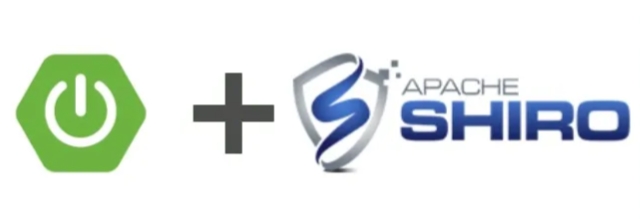《Apache Shiro 源码解析》- 11.Shiro 对 Spring 的支持
原创《Apache Shiro 源码解析》- 11.Shiro 对 Spring 的支持
原创

11.Shiro 对 Spring 的支持
Shiro 的第一个版本发布于 2004 年, Spring 项目起源于 2002 年,在 Shiro 最初的版本中没有与 Spring 相关的内容。后来,随着 Spring 的流行,从 2010 年开始, Shiro 开始提供对 Spring 的支持,推出了一个独立的 jar 包,名为 shiro-spring。从 2018 年开始, Shiro 在 v1.4 中开始增强对 SpringBoot 的支持。
在本章中,我们先解释整合的步骤,然后再对运行机制和源码进行分析,内容结构如下:
- Shiro 与 SpringBoot 的整合步骤
- 运行机制和源码分析
11.1 Shiro 与 SpringBoot 的整合步骤
11.1.1 添加项目依赖
首先,需要在 SpringBoot 项目的 pom.xml 文件中添加 Shiro 的相关依赖。以下是 Maven 的依赖配置:
<dependencies>
<!-- SpringBoot 相关的依赖,这里省略 -->
<!-- Shiro 相关的依赖 -->
<!-- 注意:由于 shiro-spring-boot-starter 与 SpringBoot 之间存在版本依赖,这里还是采用 Shiro 1.12 版本的配置方式-->
<dependency>
<groupId>org.apache.shiro</groupId>
<artifactId>shiro-spring</artifactId>
<classifier>jakarta</classifier>
<version>${shiro.version}</version>
<exclusions>
<exclusion>
<groupId>org.apache.shiro</groupId>
<artifactId>shiro-core</artifactId>
</exclusion>
<exclusion>
<groupId>org.apache.shiro</groupId>
<artifactId>shiro-web</artifactId>
</exclusion>
</exclusions>
</dependency>
<dependency>
<groupId>org.apache.shiro</groupId>
<artifactId>shiro-core</artifactId>
<classifier>jakarta</classifier>
<version>${shiro.version}</version>
</dependency>
<dependency>
<groupId>org.apache.shiro</groupId>
<artifactId>shiro-web</artifactId>
<classifier>jakarta</classifier>
<version>${shiro.version}</version>
<exclusions>
<exclusion>
<groupId>org.apache.shiro</groupId>
<artifactId>shiro-core</artifactId>
</exclusion>
</exclusions>
</dependency>
<dependency>
<groupId>org.apache.shiro</groupId>
<artifactId>shiro-ehcache</artifactId>
<version>${shiro.version}</version>
</dependency>
</dependencies>这是常见的 Maven 配置文件,不作解释。有一个点需要注意: Shiro 的版本与 SpringBoot 的版本之间存在兼容性问题,如果读者使用了最新的 SpringBoot 版本,或者使用了 shiro-spring-boot-starter ,需要自己修改配置并测试兼容性。
11.1.2 编写 ShiroConfig.java 文件
在 SpringBoot 中,Shiro 的配置通常使用 Java 配置类来实现,示例代码如下:
@Configuration
public class ShiroConfig {
//...
//这里配置一堆 Shiro 相关的 Bean
}这是常见的 Spring 配置类,不作解释。
11.1.3 实现自定义 Realm
如前所述,Realm 是 Shiro 的核心组件之一,用于从数据源中获取用户的认证和授权信息,以下是自定义 NiceFishMySQLRealm 示例:
package com.nicefish.rbac.shiro.realm;
import com.nicefish.rbac.jpa.entity.UserEntity;
import com.nicefish.rbac.service.IUserService;
import com.nicefish.rbac.shiro.util.NiceFishSecurityUtils;
import org.apache.shiro.authc.*;
import org.apache.shiro.authz.AuthorizationInfo;
import org.apache.shiro.authz.SimpleAuthorizationInfo;
import org.apache.shiro.realm.AuthorizingRealm;
import org.apache.shiro.subject.PrincipalCollection;
import org.slf4j.Logger;
import org.slf4j.LoggerFactory;
import org.springframework.beans.factory.annotation.Autowired;
import java.util.Set;
public class NiceFishMySQLRealm extends AuthorizingRealm {
private static final Logger logger = LoggerFactory.getLogger(NiceFishMySQLRealm.class);
@Autowired
private IUserService userService;
@Override
protected AuthenticationInfo doGetAuthenticationInfo(AuthenticationToken token) throws AuthenticationException {
UsernamePasswordToken usernamePasswordToken = (UsernamePasswordToken) token;
String username = usernamePasswordToken.getUsername();
String password = usernamePasswordToken.getPassword()!=null?new String(usernamePasswordToken.getPassword()):"";
UserEntity userEntity;
try {
userEntity = userService.checkUser(username, password);
logger.debug("UserName>"+username);
logger.debug("Password>"+password);
}catch (Exception e) {
logger.error(username + "登录失败{}", e.getMessage());
throw new AuthenticationException(e.getMessage(), e);
}
SimpleAuthenticationInfo info = new SimpleAuthenticationInfo(userEntity, password, getName());
return info;
}
@Override
protected AuthorizationInfo doGetAuthorizationInfo(PrincipalCollection principals) {
Integer userId= NiceFishSecurityUtils.getUserId();
Set<String> permStrs=this.userService.getPermStringsByUserId(userId);
logger.debug(permStrs.toString());
SimpleAuthorizationInfo info = new SimpleAuthorizationInfo();
info.setStringPermissions(permStrs);
return info;
}
}在 ShiroConfig.java 中配置 NiceFishMySQLRealm ,暴露给 Spring 容器:
@Bean
public NiceFishMySQLRealm nicefishRbacRealm() {
NiceFishMySQLRealm niceFishMySQLRealm = new NiceFishMySQLRealm();
niceFishMySQLRealm.setCachingEnabled(true);
niceFishMySQLRealm.setAuthenticationCachingEnabled(true);
niceFishMySQLRealm.setAuthenticationCacheName("authenticationCache");
niceFishMySQLRealm.setAuthorizationCachingEnabled(true);
niceFishMySQLRealm.setAuthorizationCacheName("authorizationCache");
return niceFishMySQLRealm;
}11.1.4 配置过滤器
在 ShiroConfig.java 中配置过滤器示例代码如下:
@Bean
public ShiroFilterFactoryBean shiroFilterFactoryBean(SecurityManager securityManager) {
ShiroFilterFactoryBean shiroFilterFactoryBean = new ShiroFilterFactoryBean();
shiroFilterFactoryBean.setSecurityManager(securityManager);
shiroFilterFactoryBean.setLoginUrl(loginUrl);
shiroFilterFactoryBean.setUnauthorizedUrl(unauthorizedUrl);
Map<String, Filter> filters = new LinkedHashMap<String, Filter>();
filters.put("captchaValidateFilter", captchaValidateFilter());
shiroFilterFactoryBean.setFilters(filters);
//所有静态资源交给Nginx管理,这里只配置与 shiro 相关的过滤器。
LinkedHashMap<String, String> filterChainDefinitionMap = new LinkedHashMap<>();
filterChainDefinitionMap.put("/nicefish/cms/post/write-post", "captchaValidateFilter");
filterChainDefinitionMap.put("/nicefish/cms/post/update-post", "captchaValidateFilter");
filterChainDefinitionMap.put("/nicefish/cms/comment/write-comment", "captchaValidateFilter");
filterChainDefinitionMap.put("/nicefish/auth/user/register", "anon,captchaValidateFilter");
filterChainDefinitionMap.put("/nicefish/auth/shiro/login", "anon,captchaValidateFilter");
filterChainDefinitionMap.put("/**", "anon");
shiroFilterFactoryBean.setFilterChainDefinitionMap(filterChainDefinitionMap);
return shiroFilterFactoryBean;
}ShiroFilterFactoryBean 是 Shiro 与 Spring 集成的核心类之一,它的主要功能是把自定义的 Filter 插入到 Spring 的过滤器链中,从而拦截到符合配置项的请求,转发给 Shiro 处理。
11.2 运行机制和源码分析
接下来,我们来解析运行机制和源代码,重点讨论以下 4 个最关键的主题:
- ShiroConfig.java 配置文件与 Bean 的生命周期管理
- SpringShiroFilter 在运行时过滤请求
- 注解扫描与方法拦截
- Session 的处理
11.2.1 ShiroConfig.java 配置文件与 Bean 的生命周期管理
在早期的版本中,开发者必须使用 XML 文件来配置 Shiro 。从 Spring 4.x 版本(2013 年左右)开始,使用 Java 代码编写配置文件逐渐成为主流,取代了大量的 XML 配置。这一趋势在 SpringBoot 推出之后(2014 年)得到了广泛普及。
Shiro 从 1.3 版本(2016 年)开始正式支持使用 Java 文件进行配置,而不再依赖 XML 或 .ini 文件配置。随着 Shiro 1.4 版本的发布,Shiro 进一步加强了对 SpringBoot 的支持,提供了 shiro-spring-boot-starter ,并改进了 @Configuration 注解的支持,使得在 SpringBoot 环境中配置 Shiro 更加方便,示例代码如下:
@Configuration
public class ShiroConfig {
//...
@Bean
//...
//...
}@Configuration 是 Spring 提供的注解,当 Spring 容器启动时,会扫描此注解,如果在其中发现了 @Bean 进行装饰的实例, Spring 就会自动管理这些实例的生命周期。
对于 Shiro 来说,需要把以下组件暴露给 Spring 容器进行管理: Realm、SecurityManager、ShiroFilterFactoryBean、CookieRememberMeManager、SessionDAO、EventBus、EhCacheManager 。
11.2.2 SpringShiroFilter 在运行时过滤请求
按照职责划分, Shiro 在整个系统中只处理与权限相关的请求。所以 Shiro 定义了自己的 Filter 用来过滤请求,类名是 SpringShiroFilter 。同时,为了配置方便, Shiro 定义了一个工厂类叫做 ShiroFilterFactoryBean ,这个类会辅助创建 SpringShiroFilter 的实例,在上面增加一些自定义的配置,代码示例如下:
@Bean
public ShiroFilterFactoryBean shiroFilterFactoryBean(SecurityManager securityManager) {
ShiroFilterFactoryBean shiroFilterFactoryBean = new ShiroFilterFactoryBean();
shiroFilterFactoryBean.setSecurityManager(securityManager);
shiroFilterFactoryBean.setLoginUrl(loginUrl);
shiroFilterFactoryBean.setUnauthorizedUrl(unauthorizedUrl);
Map<String, Filter> filters = new LinkedHashMap<String, Filter>();
filters.put("captchaValidateFilter", captchaValidateFilter());
shiroFilterFactoryBean.setFilters(filters);
//所有静态资源交给Nginx管理,这里只配置与 shiro 相关的过滤器。
LinkedHashMap<String, String> filterChainDefinitionMap = new LinkedHashMap<>();
filterChainDefinitionMap.put("/nicefish/cms/post/write-post", "captchaValidateFilter");
filterChainDefinitionMap.put("/nicefish/cms/post/update-post", "captchaValidateFilter");
filterChainDefinitionMap.put("/nicefish/cms/comment/write-comment", "captchaValidateFilter");
filterChainDefinitionMap.put("/nicefish/auth/user/register", "anon,captchaValidateFilter");
filterChainDefinitionMap.put("/nicefish/auth/shiro/login", "anon,captchaValidateFilter");
filterChainDefinitionMap.put("/**", "anon");
shiroFilterFactoryBean.setFilterChainDefinitionMap(filterChainDefinitionMap);
return shiroFilterFactoryBean;
}当 Spring 容器启动时,会解析这个 Bean ,获得过滤器的实例,并且加入到过滤器链(Filter Chain)中去。在运行时,当请求到来的时候,被匹配到的请求就会转发给 Shiro 处理。
11.2.3 注解扫描与方法拦截
当匹配到的请求转发给 Shiro 之后,方法调用链就进入了 Shiro 框架内部,接下来,我们来看 Shiro 是如何进行封装,并与 Spring 进行对接的。
Shiro 自己实现了一套轻量级的 AOP 机制,这一套机制没有 Spring 那么复杂,也不是为了取代 Spring 。在 Shiro 的 AOP 机制中,主要有两个核心的处理流程:注解扫描、方法拦截。这样实现的目的是:
- 方便与
Spring集成:当Spring启动时,AuthorizationAttributeSourceAdvisor这个类会扫描所有权限注解,对于扫描到的方法,Spring会生成代理对象,并将Shiro的MethodInterceptor加入到拦截器链中。当带有权限注解的方法被调用时,代理对象会先调用MethodInterceptor。在MethodInterceptor内部会通过SecurityManager调用相应的权限检查逻辑,如果检查通过,则继续执行方法,否则抛出异常。 - 可以脱离 Spring 框架独立运行,也可以与其它 AOP 框架集成。
我们先来看 Shiro 是如何与 Spring 配合扫描权限注解的。
在 shiro-spring-XXX-jakarta.jar 中,有一个关键的配置类 ShiroAnnotationProcessorConfiguration ,它是 Shiro 与 Spring 整合的关键桥梁。ShiroAnnotationProcessorConfiguration 的代码非常少,完整列举如下:
package org.apache.shiro.spring.config;
import org.apache.shiro.mgt.SecurityManager;
import org.apache.shiro.spring.security.interceptor.AuthorizationAttributeSourceAdvisor;
import org.springframework.aop.framework.autoproxy.DefaultAdvisorAutoProxyCreator;
import org.springframework.context.annotation.Bean;
import org.springframework.context.annotation.Configuration;
import org.springframework.context.annotation.DependsOn;
/**
* @since 1.4.0
*/
@Configuration
public class ShiroAnnotationProcessorConfiguration extends AbstractShiroAnnotationProcessorConfiguration{
@Bean
@DependsOn("lifecycleBeanPostProcessor")
protected DefaultAdvisorAutoProxyCreator defaultAdvisorAutoProxyCreator() {
return super.defaultAdvisorAutoProxyCreator();
}
@Bean
protected AuthorizationAttributeSourceAdvisor authorizationAttributeSourceAdvisor(SecurityManager securityManager) {
return super.authorizationAttributeSourceAdvisor(securityManager);
}
}- @Configuration 表示这是一个配置类,Spring 容器启动时,会自动扫描并解析这个配置类中的内容,然后自动管理其中 @Bean 的生命周期。
- 用 @Bean 注解定义了两个 Bean ,显然,这两个 Bean 已经交给 Spring 容器管理了。
- 第一个 Bean 是
DefaultAdvisorAutoProxyCreator,这是 Spring 框架中的一个类,它的作用是自动创建代理类。 @DependsOn("lifecycleBeanPostProcessor"):这个注解表示这个 Bean 的创建依赖于 lifecycleBeanPostProcessor,因为 lifecycleBeanPostProcessor 管理了 Shiro 中一些重要 Bean 的生命周期。 - 第二个 Bean 是
AuthorizationAttributeSourceAdvisor,这是 Shiro 自己实现的一个 AOP 顾问类,这个类非常关键,它负责在运行时检查被调用的方法上是否带有权限注解。
AuthorizationAttributeSourceAdvisor 的关键源代码如下:
public class AuthorizationAttributeSourceAdvisor extends StaticMethodMatcherPointcutAdvisor {
private static final Class<? extends Annotation>[] AUTHZ_ANNOTATION_CLASSES =
new Class[] {
RequiresPermissions.class, RequiresRoles.class,
RequiresUser.class, RequiresGuest.class, RequiresAuthentication.class
};
//这里很关键,在构造函数中直接 new 了一个顾问,并调用 setAdvice 设置给 Spring。
public AuthorizationAttributeSourceAdvisor() {
setAdvice(new AopAllianceAnnotationsAuthorizingMethodInterceptor());
}
//...
//这里扫描指定的 Class 上是否存在权限注解。
private boolean isAuthzAnnotationPresent(Class<?> targetClazz) {
for( Class<? extends Annotation> annClass : AUTHZ_ANNOTATION_CLASSES ) {
Annotation a = AnnotationUtils.findAnnotation(targetClazz, annClass);
if ( a != null ) {
return true;
}
}
return false;
}
//...
}整体上说, Shiro 自己实现了一个方法切点顾问类(Method Pointcut Advisor),通过 @Configuration 和 @Bean 这两个注解,把它暴露给 Spring 去管理,而在顾问类的构造方法中,直接设置了一个方法拦截器,也就是名字很长的 AopAllianceAnnotationsAuthorizingMethodInterceptor。在运行时,这个方法拦截器将会拦截所有带有权限注解的方法,先进行权限校验。
那么, AopAllianceAnnotationsAuthorizingMethodInterceptor 具体又做了什么呢?我们来看它的关键源代码(已省略无关代码):
public class AopAllianceAnnotationsAuthorizingMethodInterceptor
extends AnnotationsAuthorizingMethodInterceptor implements MethodInterceptor {
public AopAllianceAnnotationsAuthorizingMethodInterceptor() {
List<AuthorizingAnnotationMethodInterceptor> interceptors =
new ArrayList<AuthorizingAnnotationMethodInterceptor>(5);
//use a Spring-specific Annotation resolver - Spring's AnnotationUtils is nicer than the
//raw JDK resolution process.
AnnotationResolver resolver = new SpringAnnotationResolver();
//we can re-use the same resolver instance - it does not retain state:
//注意这里的拦截器, 把 Shiro 实现的5种注解拦截器全部加入到拦截器中去。
interceptors.add(new RoleAnnotationMethodInterceptor(resolver));
interceptors.add(new PermissionAnnotationMethodInterceptor(resolver));
interceptors.add(new AuthenticatedAnnotationMethodInterceptor(resolver));
interceptors.add(new UserAnnotationMethodInterceptor(resolver));
interceptors.add(new GuestAnnotationMethodInterceptor(resolver));
setMethodInterceptors(interceptors);
}
}权限注解拦截器相关的继承结构如下:

我们来分析 PermissionAnnotationMethodInterceptor 的实现,其它拦截器的实现逻辑类似,在 PermissionAnnotationMethodInterceptor 内部,会调用工具类 PermissionAnnotationHandler来负责真正的权限检测功能,其中的关键代码如下(已省略无关代码):
public class PermissionAnnotationHandler extends AuthorizingAnnotationHandler {
//...
public void assertAuthorized(Annotation a) throws AuthorizationException {
if (!(a instanceof RequiresPermissions)) return;
RequiresPermissions rpAnnotation = (RequiresPermissions) a;
String[] perms = getAnnotationValue(a);
Subject subject = getSubject();
if (perms.length == 1) {
//检查权限
subject.checkPermission(perms[0]);
return;
}
if (Logical.AND.equals(rpAnnotation.logical())) {
//检查权限
getSubject().checkPermissions(perms);
return;
}
if (Logical.OR.equals(rpAnnotation.logical())) {
// Avoid processing exceptions unnecessarily - "delay" throwing the exception by calling hasRole first
boolean hasAtLeastOnePermission = false;
for (String permission : perms) if (getSubject().isPermitted(permission)) hasAtLeastOnePermission = true;
// Cause the exception if none of the role match, note that the exception message will be a bit misleading
if (!hasAtLeastOnePermission) getSubject().checkPermission(perms[0]);
}
}
}也就是说:只要我们在某个方法加上了权限注解, Spring 在启动的时候就会自动创建代理类。然后在运行时,当这个方法被调用的时候,Shiro 中的对应的权限拦截器就会首先被执行,这就是权限注解的运行机制。
11.2.4 Session 的处理
在 ShiroConfig 中,一般还会配置 SessionManager 的实例,并且通过 @Bean 注解暴露给 Spring ,让 Spring 容器去管理它的生命周期,示例代码如下:
@Bean
public DefaultWebSessionManager sessionManager() {
DefaultWebSessionManager defaultWebSessionMgr = new DefaultWebSessionManager();
//启用 EhCache 缓存,Shiro 默认不启用
//启用 EhCache 缓存之后,需要在持久化的 Session 和缓存中的 Session 之间进行数据同步。
//EhCache 实例配置位于 classpath:ehcache-shiro.xml 文件中,session 默认缓存在 "shiro-activeSessionCache" 实例中。
//认证、授权、Session,全部使用同一个 EhCache 运行时对象。
defaultWebSessionMgr.setCacheManager(ehCacheManager());
defaultWebSessionMgr.setDeleteInvalidSessions(true);
defaultWebSessionMgr.setGlobalSessionTimeout(timeout);
defaultWebSessionMgr.setSessionIdUrlRewritingEnabled(false);
//启用定时调度器,用来清理 Session ,Shiro 默认采用内置的 ExecutorServiceSessionValidationScheduler 进行调度。
defaultWebSessionMgr.setSessionValidationSchedulerEnabled(true);
defaultWebSessionMgr.setSessionValidationInterval(validationInterval);
defaultWebSessionMgr.setSessionDAO(sessionDAO());
defaultWebSessionMgr.setSessionFactory(sessionFactory());
return defaultWebSessionMgr;
}在之前的内容中,我们已经知道, SessionManager 的实例最终会被设置给 SecurityManager ,这个动作是由 Spring 的依赖注入机制自动完成的。关于 SessionManager 与 SecurityManager 之间的关系,请翻阅“第三章 身份验证与授权”,这里不再解释。
11.3 本章小结
本章详细分析了 Shiro 与 SpringBoot 整合时的运行机制。
资源链接
- Apache Shiro 在 github 上的官方仓库: https://github.com/apache/shiro
- Apache Shiro 官方网站:https://shiro.apache.org/
- 本书实例项目:https://gitee.com/mumu-osc/nicefish-spring-boot
- 本书文字稿:https://gitee.com/mumu-osc/apache-shiro-source-code-explaination
版权声明
本书基于 CC BY-NC-ND 4.0 许可协议发布,自由转载-非商用-非衍生-保持署名。
版权归大漠穷秋所有 © 2024 ,侵权必究。
原创声明:本文系作者授权腾讯云开发者社区发表,未经许可,不得转载。
如有侵权,请联系 cloudcommunity@tencent.com 删除。
原创声明:本文系作者授权腾讯云开发者社区发表,未经许可,不得转载。
如有侵权,请联系 cloudcommunity@tencent.com 删除。
